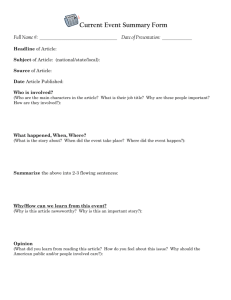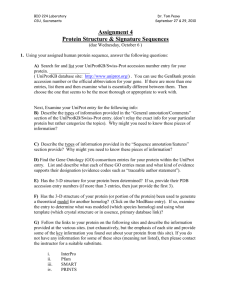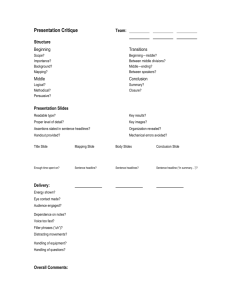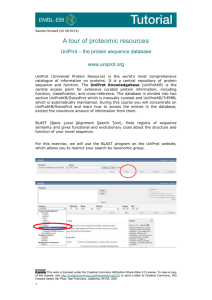PSI
advertisement
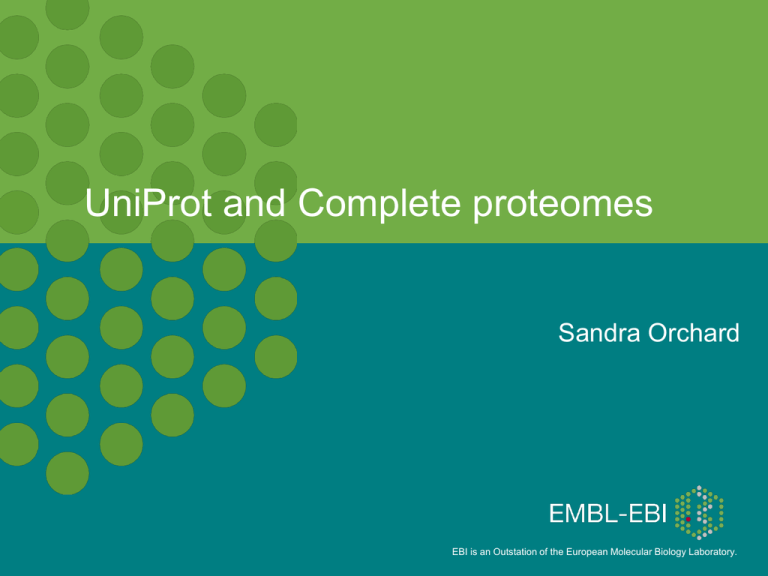
UniProt and Complete proteomes Sandra Orchard EBI is an Outstation of the European Molecular Biology Laboratory. Importance of reference protein sequence databases Computational analysis and biological interpretation of shotgun proteomic data requires a reference protein sequence database • Completeness and minimal redundancy A non redundant protein sequence database, with maximal coverage including splice isoforms, disease variant and PTMs. Low degree of redundancy for facilitating peptide assignments • Stability and consistency Stable identifiers and consistent nomenclature Databases are in constant change due to a substantial amount of work to improve their completeness and the quality of sequence annotation • High quality protein annotation Detailed information on protein function, biological processes, molecular interactions and pathways cross-referenced to external source Summary of some protein sequence databases used in proteomics Database Description Species UniProtKB Expertly curated section (UniProtKB/Swiss-Prot) and computerannotated section (UniProtKB/TrEMBL); minimum level of redundancy; high level of integration with other databases; stable identifiers; diversity of sources including large scale genomics, small scale cloning and sequencing, protein sequencing, PDB, predicted sequences from Ensembl and RefSeq Many UniRef100 Assembled from UniProtKB, Ensembl and RefSeq; merges 100% identical sequences; stable identifiers Many Ensembl Predictions using automated genome annotation pipeline; explicitly linked to nucleotide and protein sequences; stable reference; merge their annotations with Vega annotations at transcript level; extensive quality checks to remove erroneous gene models ; high level of integration with other databases Over 50 Eukaryotic genomes Expanded Ensembl Metazoa, Plants and Fungi, Protists, Bacteria and Archaea RefSeq NCBI creates from existing data; ongoing curation; non-redundant; explicitly linked nucleotide and protein sequences; stable reference; high level of integration with other databases Limited to fully sequenced organisms IPI Good balance between degree of redundancy and completeness; references to primary data sources; attempts to maintain stable identifiers; Assembled from UniProtKB, RefSeq and Ensembl 7 eukaryotic genomes Entrez protein (NCBInr) Assembled from GenBank and RefSeq coding sequence translations and UniProt KB ; annotations extracted from source curated databases; high degree of sequence redundancy Many Updated from Nesvizhskii, A. I., and Aebersold, R. (2005) Interpretation of shotgun proteomic data: the protein inference problem. Mol. Cell. Proteomics. 4,1419–1440l Protein sequences: UniProt databases 4 IPI Closure • IPI was launched in 2001 to cover the gaps in gene predictions between different databases • It is an integrated database which clusters protein sequences from different databases (e.g. UniProt, Ensembl and Refseq) to provide non-redundant complete data sets for human, mouse, rat, zebrafish, arabidopsis, chicken and cow. • Collaboration efforts between Ensembl, Refseq and UniProt to improve gene prediction quality coverage for many of the most-studied genomes. Collaboration projects between database resources • CCDS project, a collaboration between Ensembl, NCBI, UCSC and UniProt, aims to provide a standard set of gene predictions for the human and mouse genomes • Considerable communication effort between curators from different groups is on-going • Ensembl and UniProt collaboration to cover the gaps in gene predictions in UniProtKB (one sequence for each protein coding transcript in Ensembl) • Ensembl high quality gene/transcript models (quality checks remove gene models with erroneous structures or supported by dubious evidence – e.g. cDNA fragments with short/wrongly annotated ORF) • UniProtKB high quality protein sequences Complete proteome data set for IPI species • Complete proteome data sets for IPI species are based on existing UniProtKB sequences supplemented by high quality predictions imported from Ensembl • Includes the UniProtKB/Swiss-Prot manual annotated protein sequences supplemented by protein sequences in UniProtKB/TrEMBL from high quality predictions crossreferenced or imported from Ensembl Complete proteome data sets for IPI species in UniProtKB • Ensembl sequences have now been incorporated for all the species represented in IPI: human, mouse, rat , zebrafish, chicken and cow. • Also for species such as dog, pig, C.elegans, Drosophila melanogaster and Saccharomyces cerevisiae. • Complete proteome keyword by release 2011_07 of 28th June • Fasta files by FTP • One file per species containing canonical + isoform sequences • Will work in other species of interest Manual annotation of the human proteome (UniProtKB/Swiss-Prot) – May 2010 • A draft of the complete human proteome has been available in UniProtKB/Swiss-Prot since 2008 • Manually annotated representation of 20,252 protein coding genes with over 35,000 protein sequences - an additional 41,000 UniProtKB/TrEMBL form the complete proteome set • Approximately 63,000 single amino acid polymorphisms (SAPs), mostly disease-linked • 80,000 post-translational modifications (PTMs) • Close collaboration with NCBI, Ensembl, Sanger Institute and UCSC to provide the authoritative set to the user community Finding a complete proteome in UniProtKB Complete Proteomes Selecting a sequence set UniProtKB/TrEMBL Multiple entries for the same protein (redundancy) can arise in UniProtKB/TrEMBL due to: o Erroneous gene model predictions o Sequence errors (Frame shifts) o Polymorphisms o Alternative start sites o Isoforms Apart from 100% identical sequences all merged sequences are analysed by a curator so they can be annotated accordingly. Manual annotation of UniProtKB/Swiss-Prot Splice variants Sequence Sequence features UniProtKB Ontologies Annotations Nomenclature References Sequence curation, stable identifiers, versioning and archiving For example – erroneous gene model predictions, frameshifts …. ..premature stop codons, read-throughs, erroneous initiator methionines….. Master headline Splice variants Master headline Domain annotation Binding sites Master headline Identification of amino acid variants ..and of PTMs Master headline Statistics of Protein Modifications Number of Different Modifications 160 140 120 100 80 60 40 20 0 D E N Q S T C M H K R G A P V L I F Y W fM U O Number of different modifications produced from each of the encoded amino acids, as currently annotated in the RESID Database of Protein Modifications (523 total). 15 Jul 2010 Statistics of Protein Modifications Number of Annotated Modifications in UniProt 400000 350000 300000 250000 200000 150000 100000 50000 0 D E N Q S T C M H K R G A P V L I F Y W fM U O Number of modifications produced from each of the encoded amino acids in all the proteins currently annotated in the UniProt Knowledgebase. 15 Jul 2010 Understanding PTMs – additional resources High quality PTM annotation required for peptide identification – must take additional weight of any PTM into account RESID (www.ebi.ac.uk/resid) - collection of annotations and structures for protein modifications and cross-links including pre-, co-, and post-translational modifications. - provides systematic and alternate names, atomic formulas and masses, enzymatic activities that generate the modifications, keywords, literature citations, Gene Ontology (GO) crossreferences, protein sequence database feature table annotations, structure diagrams, and molecular models. Master headline Understanding PTMs – additional resources Requirements for MS 1. Both specific (O-phospho-L-serine) and ambiguous (phosphorylation) chemical terms are needed to describe modifications at different levels of experimental resolution. 2. Must include protein cross-linking modifications. 3. Must include artificial modifications 4. Must include masses and mass differences 5. Must provide for sequential modifications on the same residue, and for neutral losses Master headline Understanding PTMs – additional resources PSI-MOD - community standard ontology that reconciles descriptions of protein residue modifications across multiple resources (UniProt, RESID, UniMOD, DeltaMass) www.ebi.ac.uk/ontology-lookup/browse.do?ontName=MOD Master headline Protein nomenclature Master headline Master headline Annotation - >30 defined fields Controlled vocabularies used whenever possible… Master headline ..and also imported from external resources Binary interactions taken from the IntAct database Interactors of human p53 Master headline Controlled vocabulary usage increasing – for example from the Gene Ontology Annotation for human Rhodopsin Master headline Sequence evidence Type of evidence that supports the existence of a protein 1 Evidence at protein level There is experimental evidence of the existence of a protein (e.g. Edman sequencing, MS, X-ray/NMR structure, good quality protein-protein interaction, detection by antibodies) 2 Evidence at transcript level The existence of a protein has not been proven but there is expression data (e.g. existence of cDNAs, RT-PCR or Northern blots) that indicates the existence of a transcript. 3 Inferred from homology The existence of a protein is likely because orthologs exist in closely related species 4 Predicted 5 Uncertain UniProtKB/TrEMBL Multiple entries for the same protein (redundancy) can arise in UniProtKB/TrEMBL due to: o Erroneous gene model predictions o Sequence errors (Frame shifts) o Polymorphisms o Alternative start sites o Isoforms Apart from 100% identical sequences all merged sequences are analysed by a curator so they can be annotated accordingly. Automatic Annotation •Automated clean-up of annotation from original nucleotide sequence entry • Additional value added by using automatic annotation •Recognises common annotation belonging to a closely related family within UniProtKB/Swiss-Prot • Identifies all members of this family using pattern/motif/HMMs in InterPro • Transfers common annotation to related family members in TrEMBL Master headline Master headline Searching UniProt – Simple Search • Text-based searching • Logical operators ‘&’ (and), ‘|’ Master headline Searching UniProt – Advanced Search Master headline Searching UniProt – Search Results Each linked to the UniProt entry Master headline Searching UniProt – Search Results Master headline Searching UniProt – Search Results Master headline Searching UniProt – Blast Search Master headline Searching UniProt – Blast Search Master headline Searching UniProt – Blast Results Alignment with query sequence Master headline Searching UniProt – Blast Results Master headline Contributing to UniProtKB
![[Type text] Fill in a fictional “headline from the future” above](http://s3.studylib.net/store/data/008674091_1-c12eeba0d4bd6938777e08ea064ad30a-300x300.png)
